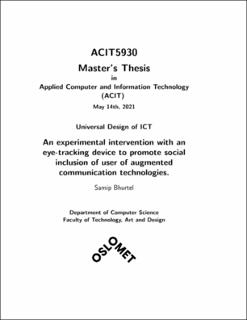| dc.description.abstract | In this thesis, we design and perform an experiment using an eye-tracker, communication interface and questionnaires to promote empathy towards people with communication difficulties.
People with communication difficulties face lots of problems to be understood. Assistive technology helps individuals who cannot communicate verbally, people suffering from tetraplegia, locked-in syndrome, and brain paralysis.
Assistive technology alone does not entirely fulfill the communication needs because the attitude towards non-verbal people has not always been good. For controlling bad attitudes towards non-verbal people, society should know the difficulties faced by non-verbal people by getting into their shoes.
In this context,
we design a new framework to promote empathy and to help better social inclusion of the particular
group of non-verbal individuals.
We use a validated questionnaire, called QCAE (Questionnaire of Cognitive and Affective Empathy), to assess the level of empathy, composed of 31 questions, and add 9 more questions for the specific context of communication with eye-tracker to fit the design of our experiment.
The result shows that, while the empathy level of participants does not increase significantly, the statistical power obtained for our extended questionnaire (75%) is not far from the standardly accepted
power value (80\%) to reject the null hypothesis. Moreover, the power of our extended questionnaire is considerably larger than the power obtained with QCAE (63%).
Finally, a discussion for future directions of the study is also presented. | en_US |
